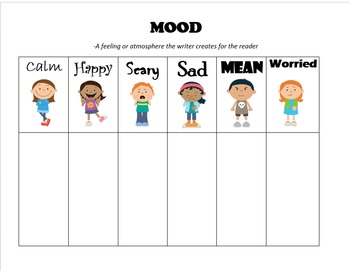

- #Different moods in writing full#
- #Different moods in writing plus#
- #Different moods in writing professional#
The author of an informal piece may also convey more emotion and personal opinions in the piece.Įxample: “Hey, what's up? I'm calling to see if you want to catch a flick tonight with me and my buddies?” 3. Pieces written in an informal tone may include colloquial or slang phrases and shortened words, such as contractions. Some people write in the same way they speak to a friend, and this is known as an informal tone of writing. Informal is the opposite tone of formal and sounds more conversational. Related: Writing Skills: Definition and Examples 2. It is grammatically correct and emphasizes facts rather than opinions.Įxample: “According to the data presented, the yellow tree frog mates between April and June.”
#Different moods in writing full#
Formal pieces often include full words with no contractions or other shortened words and does not include slang terms.
#Different moods in writing professional#
FormalĪ formal tone is common in a professional or academic context, when the piece needs to be direct and thorough while maintaining a respectful feel. Related: 10 Communication Skills for Career Success 13 examples of tone in writingĪs you review the meaning of tone in writing, you can also look at various examples of tone to get a better sense of what each might look like in your own writing. An author might also use different tones in various pieces they write. Tone might stay the same throughout a piece, or it might change to reflect a shift in the story or mood. In literature, tone refers to how the author expresses their attitude throughout their writing. A more formal piece might reflect a more serious topic, while a lighthearted story might use less formal words and diction. Tone also refers to the complexity of the writing, along with the formality of the words used. Additional factors that impact the tone of a piece include the verbs and adjectives you use and how you utilize imagery to tell the story.

You might also use your feelings about the story or situation you are presenting in the written communication to reflect the tone. When you write, your mood at that time might have an impact on the overall tone of your piece. A written piece might have a positive or uplifting tone, or the tone might feel sad or tense. The tone used in writing refers to the feeling the words invoke in the reader.
#Different moods in writing plus#
In this article, we discuss what tone in writing is, plus we provide a guide covering 13 examples of tone to help guide you when working on writing of your own. Understanding tone and its applications in various writing methods can help you determine how you want to convey your message to others. These writing choices are known as the tone of a written piece, which is similar to the tone of voice used when communicating orally. The way you write and the word choices you make in your writing confer feelings and emotions on the reader. A person sits at their desk in a home office decorated by potted plants and lit by natural light.


 0 kommentar(er)
0 kommentar(er)
